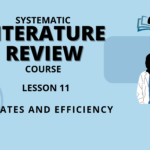
The Role of Literature Reviews in Research
Literature reviews are fundamental in scholarly research, serving as a bridge between existing knowledge and new inquiries. They are not just an academic formality but a critical element in understanding and analyzing the current state of knowledge on a particular topic. In writing literature reviews, researchers sift through a myriad of journal articles, books, and other scholarly sources to establish the context and relevance of their research.
The Importance of Literature Reviews in Medical Device Development
A literature review in medical device development serves as a crucial component, acting as a bridge between existing knowledge and new research. It systematically gathers and analyzes existing research, journal articles, and cultural sources to provide a comprehensive understanding of the current state of technology and development in the medical device industry. This integrative approach helps in identifying key concepts, recurring themes, and turning points in the field. Writing literature reviews in this context goes beyond mere summarization; it involves critically evaluating other researchers’ work, drawing connections between different aspects and disciplines, and presenting a coherent whole that informs further discovery and development.
The Growing Demand for Medical Devices in Europe
The increasing demand for medical devices, as reported in recent market analyses, underscores the necessity for comprehensive literature reviews. These reviews provide an overview of the current market, including trends, key debates, and new developments that have occurred over a specified period. Good literature reviews in this area would utilize a variety of scholarly sources, including articles from Google Scholar and other databases, to paint a detailed picture of the industry. This process involves summarizing sources, but also critically evaluating them to identify gaps in the market that new medical devices could fill. There are over 500,000 types of medical devices and IVDs on the EU market and hundreds of companies producing medical devices, ranging from large multinational corporations to small businesses. These companies are responsible for creating a wide range of products, including diagnostic imaging equipment, implantable devices, and surgical tools.
Diversity in the EU Medical Device Market
In exploring the diversity of the EU medical device market, literature reviews play a pivotal role. They help in understanding the range of medical devices and innovations present in the market. This involves reviewing literature across various theories and methodological approaches and summarizing findings from a wide array of sources. Writing literature reviews in this area requires identifying and analyzing the different types of medical devices available, the companies involved, and the specific theoretical and technological advancements that distinguish them. The review should draw connections between different disciplines, such as engineering, computer science, and social sciences, to provide a comprehensive understanding of the market’s diversity.
Key Drivers of the Medical Device Manufacturing Industry
Writing a literature review that focuses on the key drivers of the medical device manufacturing industry involves a thorough analysis of the existing research and scholarly sources. This type of review needs to critically evaluate the literature to identify the main points and key findings related to industry drivers like aging populations, healthcare spending, and technological advancements. The review should include a well-structured analysis of how these factors contribute to the industry’s growth and development. It should also consider different aspects, such as economic, demographic, and technological factors, to provide a multidimensional perspective on what drives the industry forward.
In each of these sections, the literature review acts as a foundational element in synthesizing existing knowledge, offering new insights, and guiding future research and development in the medical device industry. The process of writing these reviews requires a deep understanding of the research question, a methodological approach to gathering and analyzing relevant literature, and the ability to critically evaluate and integrate information from various sources into a comprehensive and informative review.
Technology Solutions for Data Management in Device Manufacturing
The increasing complexity and volume of data in the medical device industry necessitate effective data management strategies, a topic thoroughly explored in literature reviews. These reviews scrutinize existing research, journal articles, and case studies to identify best practices and technological innovations in data management. A good literature review in this area would highlight key concepts, such as cloud computing, data analytics, and cybersecurity measures, critical in modern manufacturing processes. It would involve reviewing literature from various disciplines, including computer science and information technology, to provide a comprehensive understanding of the current state of data management solutions in the industry.
Such integrative literature reviews are essential in guiding manufacturers on how to handle the vast amount of data generated during the research and development phase. By critically evaluating existing knowledge and drawing connections between different methodological approaches, these reviews help manufacturers in adopting the most effective data management strategies. Moreover, these reviews often lead to more research, identifying gaps in current practices and suggesting new angles for exploration. The annotated bibliography included in these reviews serves as a valuable resource for manufacturers, providing them with quick access to relevant studies and articles.
Lastly, the literature review process in this domain often uncovers recurring central themes, such as the importance of data security and the role of artificial intelligence in data analysis. This helps manufacturers stay abreast of key debates and developments in the field, ensuring that their data management practices are not only effective but also aligned with the latest industry standards and expectations. Writing such a review requires a careful selection of scholarly sources, well-structured paragraphs, and a coherent synthesis of the information to present a clear overview of current and potential future practices in data management.
The Role of Research and Literature Reviews in Device Development
In the development of medical devices, literature reviews serve as a cornerstone, providing a detailed overview of existing research and highlighting areas that require further exploration. A well-conducted literature review in this context involves a thorough examination of research papers, journal articles, and other relevant literature, focusing on the particular topic of the device under development. This process allows developers to build upon existing knowledge, avoiding redundancy and ensuring that their new product or innovation adds value to the field.
A good literature review for a medical device development project not only summarizes existing research but also critically evaluates it. This involves identifying key findings, understanding various theoretical approaches, and assessing the research methods used by other researchers. By doing so, developers gain a deeper insight into the current knowledge and trends in their field, allowing them to position their own research and product development in a way that addresses unmet needs or improves upon existing solutions.
Furthermore, literature reviews in device development often reveal the cultural and social implications of medical technologies, an aspect crucial for ensuring that the devices are suitable for their intended user base. By incorporating a range of perspectives from different disciplines, such as social sciences and cultural studies, a literature review can provide a more holistic view of the device’s potential impact. Additionally, the review process itself contributes to the overall research project, helping to refine the research question, guide the research process, and shape the methodological approach. The final literature review section of a research paper thus becomes a testament to the comprehensive and integrative research effort, paving the way for successful device development and future academic publication.
Let us take a look at why the literature review is such a cornerstone of the CER.
Significance of Clinical Evaluation Reports (CER) for Medical Devices
Clinical Evaluation Reports (CERs) are fundamental documents in the medical device industry, and literature reviews play a critical role in their composition. A good literature review in a CER context involves an exhaustive analysis of research papers and journal articles related to the medical device. This review must critically evaluate existing research and relevant literature to establish the safety and efficacy of the device. The literature review section in CERs often includes an annotated bibliography, summarizing key findings and providing insights into the current state of knowledge in the field.
The process of writing a literature review for a CER demands a thorough understanding of the research question and the existing knowledge around the medical device. It should cover various theoretical and methodological approaches, ensuring that the review is comprehensive and integrative. By doing so, the literature review provides substantial evidence to support the claims made about the device, contributing significantly to the overall quality and credibility of the CER. Moreover, the insights gained from these reviews guide further research and development, helping to identify areas where more investigation is needed.
Lastly, the literature review in a CER helps in identifying and addressing key debates and themes in the field. This comprehensive analysis ensures that the medical device in question aligns with the current standards and practices in healthcare, thereby facilitating its acceptance by regulatory bodies and healthcare professionals. The literature review thus becomes a crucial part of the CER, synthesizing existing research into a coherent whole that supports the clinical evaluation process.
Objectives of Literature Reviews in the Medical Device Industry
In the medical device industry, the objectives of literature reviews extend beyond mere documentation. A well-structured literature review serves to analyze current knowledge, integrating findings from various sources like journal articles, research papers, and other scholarly sources. The review seeks to identify key concepts, recurring themes, and new knowledge that can contribute to the development and improvement of medical devices. This process involves drawing connections between different aspects and disciplines, enhancing the depth and breadth of the analysis.
Critical Objective For Literature Reviews
The critical objective of literature reviews in this field is to guide the research process for new device development. By critically evaluating existing research and identifying gaps in the literature, these reviews provide a foundation for new research projects. They help in formulating research questions, selecting appropriate research methods, and determining the scope of the research. Writing a literature review in this context is a step-by-step guide that aids researchers in navigating the vast array of existing literature, enabling them to build upon the work of other researchers effectively.
Practical Applications of Medical Devices
Literature reviews in the medical device industry are instrumental in informing both the theoretical scholarship and practical applications of medical devices. They offer insights into different methodological approaches and cultural sources, contributing to a more nuanced understanding of the devices’ potential impact. Such reviews are crucial in the decision-making process for further development and investment in new technologies, ensuring that the research and development efforts are aligned with the industry’s needs and standards.
The Necessity of Literature Reviews for Clinical Evaluation
Literature reviews are indispensable in the clinical evaluation of medical devices. They provide a comprehensive overview of the existing research and developments that have occurred in the field, serving as a foundation for assessing a device’s safety and efficacy. A good literature review for clinical evaluation purposes goes beyond summarizing sources; it critically evaluates and synthesizes information from various theories and disciplines, including social sciences and computer science.
These reviews are essential for identifying the key findings and debates in the field, helping manufacturers and researchers understand the current state of knowledge and practice. They enable the identification of new angles and perspectives that might not have been considered previously, enriching the clinical evaluation process. Additionally, literature reviews in this context often include an annotated bibliography, which serves as a quick reference for other researchers and stakeholders involved in the device’s development and evaluation.
How Literature Reviews Facilitate Future Clinical Updates
Literature reviews play a vital role in facilitating future clinical updates for medical devices. By providing a thorough analysis of existing research, these reviews help manufacturers stay updated with the latest developments, key themes, and turning points in the field. This knowledge is crucial for making informed decisions about future updates and improvements to the devices. A good literature review in this context not only summarizes the current state of knowledge but also identifies areas where new research and development are needed.
These reviews also aid in drawing connections between different research findings and theoretical approaches. This integrative analysis helps in understanding the broader implications of the research and how it can be applied to future clinical updates. By critically evaluating the literature, manufacturers and researchers can gain insights into the effectiveness of current devices and identify potential areas for innovation and enhancement.
Lastly, literature reviews are essential tools for guiding the research process for future updates. They provide a structured and comprehensive overview of the research conducted on similar devices, helping to inform the development of new research questions and methodologies. This step-by-step guide through the literature ensures that future research is well-informed and targeted towards addressing the most pressing needs and gaps in the field. The literature review, therefore, becomes a foundational component in the ongoing development and improvement of medical devices.
Flows into Your PMS Documents
Literature reviews significantly contribute to Post-Market Surveillance (PMS) documentation for medical devices. A comprehensive literature review integrates various aspects of existing research, including journal articles and research papers, to provide an in-depth analysis of the device’s performance and safety post-market. This process involves reviewing literature from different disciplines, ensuring a broad perspective on the device’s impact and effectiveness in real-world scenarios.
The role of a good literature review in PMS documentation is twofold. Firstly, it critically evaluates current knowledge and key concepts relevant to the device, helping to identify any emerging issues or trends in its usage. This includes analyzing user feedback, clinical data, and other articles that shed light on the device’s performance. Secondly, the literature review aids in establishing a robust methodological approach for ongoing surveillance. It guides the research process, outlining relevant research questions and suggesting appropriate research methods to monitor and assess the device’s performance continuously.
The Marketer’s Dream Document
In the realm of medical device marketing, a well-conceived literature review is akin to a dream document. It serves as a powerful tool for communicating the value and uniqueness of a medical device to potential customers and stakeholders. A good literature review in this context delves deep into existing research, journal articles, and other relevant literature to draw out key insights about the market needs and the device’s potential to meet these needs.

The literature review provides a comprehensive overview of the current state of the art, highlighting how the new device addresses unmet needs or improves upon existing solutions. This involves not only summarizing the existing knowledge but also critically evaluating it to identify key debates, themes, and developments in the field. Such an analysis helps marketers articulate the unique selling points of the device, backed by solid research and evidence.
Tricks to great literature reviews
But what makes a good literature review?
How can medical device manufacturers ensure that their literature review will help them identify the need for their device and the market space it occupies?
The way you conduct your literature review depends on your research questions, but here are some tried-and-true strategies that can help you write a great literature review:
- Define your research question
- Determine what type of information you need to answer your research question (primary sources, secondary sources, etc.)
- Identify potential databases/indexes that might be useful
- Search major databases/indexes using relevant keywords
Recent Posts
- Lesson 12 – Systematic Literature Review Course: Final Exam
- Lesson 11 – Systematic Literature Review Course: Updates and Efficiency
- Lesson 10 – Systematic Literature Review Course: Comprehensive Guide to IVDR Literature
- Lesson 9 – Systematic Literature Review Course: Most Common Notified Body Feedback During Audits
- Lesson 8 – Systematic Literature Review Course: Are You a Qualified Reviewer?






